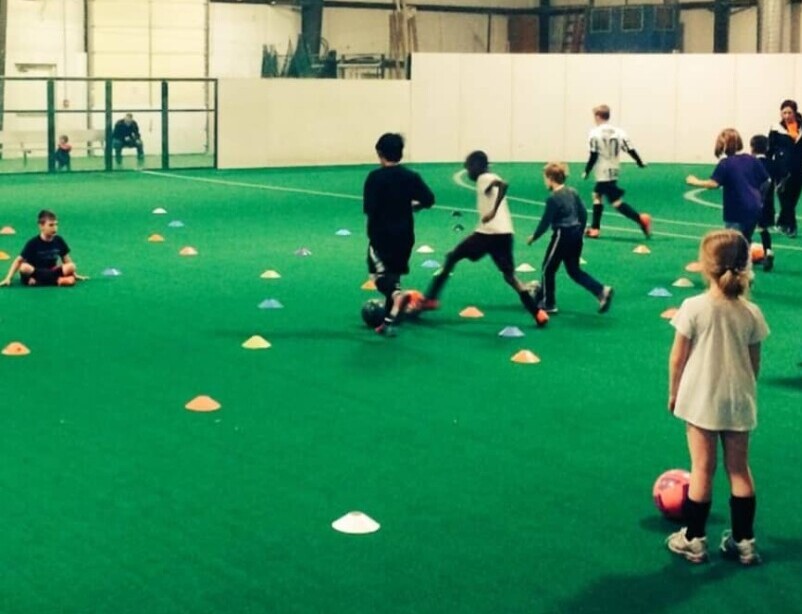Introduction to the Dribbling with Feints Drill:
The Dribbling with Feints Drill focuses on enhancing a player’s ability to deceive and outmaneuver defenders using a variety of feints and dribbling techniques.
This drill is crucial for developing creativity, agility, and confidence on the ball.
By practicing feints, players learn to create space, change direction quickly, and keep defenders guessing, making it a vital skill for any soccer player.
Setting Up the Drill:
- Equipment Needed:
-
- Soccer ball
- Cones (at least 4-6)
- A flat, open space (such as a soccer field or training ground)
- Setup Instructions:
-
- Set up a line of cones spaced about 2-3 meters (6-10 feet) apart. The length of the cone line can vary based on available space and player skill level.
- Ensure the cones are firmly placed to prevent them from moving during the drill.
Executing the Dribbling with Feints Drill:
- Starting Position:
-
- Begin at the first cone with the soccer ball at your feet.
- Stand with a balanced posture, knees slightly bent, and ready to move.
- Dribbling Through the Cones:
-
- Using Both Feet: Dribble the ball towards the first cone, alternating touches with the inside and outside of both feet. Focus on maintaining close control and quick changes of direction.
- Performing Feints: As you approach each cone, perform a feint to simulate outmaneuvering a defender. Popular feints include:
-
- Step-Over: Step over the ball with one foot, then use the outside of the other foot to push the ball in the opposite direction.
- Body Feint: Lean your body to one side as if you are going to move in that direction, then quickly push the ball in the opposite direction with the outside of your foot.
- Double Touch: Use the inside of your foot to tap the ball to the opposite side, then quickly push it back with the outside of the same foot.
- Scissors: Perform a circular motion around the ball with one foot, then push the ball with the outside of the other foot.
- Quick Changes of Direction: After each feint, quickly change direction to navigate around the cone and move towards the next cone.
- Maintaining Control:
-
- Head Up: Keep your head up as much as possible to simulate game scenarios where you need to be aware of your surroundings while dribbling.
- Body Positioning: Maintain a low center of gravity by bending your knees and leaning slightly forward. This stance helps in making quick adjustments and staying balanced.
- Light Touches: Use light, frequent touches to maneuver the ball. Avoid heavy touches that can cause the ball to stray away from your path.
Advanced Variations:
- Increase Speed:
-
- Gradually increase the speed at which you dribble through the cones while maintaining control. This adds an element of intensity and helps simulate game conditions.
- Combination Feints:
-
- Combine multiple feints in one dribbling sequence to make your moves more unpredictable. For example, perform a step-over followed by a body feint.
- Dynamic Defenders:
-
- Introduce dynamic defenders (cones that move or actual players) to increase the challenge and better simulate real-game scenarios.
- Freestyle Feints:
-
- Allow players to use any feints they know, encouraging creativity and experimentation with different moves.
Common Mistakes to Avoid:
- Over-Reliance on Dominant Foot:
-
- Avoid using only your dominant foot. Ensure you’re developing skills in both feet for balanced dribbling ability.
- Looking Down at the Ball:
- Constantly looking down at the ball can hinder your awareness of the field. Practice keeping your head up to improve field vision.
- Overcomplicating Feints:
- Keep your feints simple and effective. Overcomplicating moves can slow you down and reduce effectiveness.
Benefits of the Dribbling with Feints Drill:
- Improved Agility and Balance:
- The quick changes of direction and deceptive moves improve your overall agility and balance, making you more adept at sudden movements during games.
- Enhanced Ball Control:
- Regular practice enhances your ability to control the ball in tight spaces, crucial for navigating through defenders.
- Increased Confidence and Creativity:
- Mastering feints boosts your confidence in dribbling and handling the ball under pressure. It also encourages creativity, allowing you to come up with new ways to outmaneuver opponents.
Incorporating the Drill into Your Training Routine:
- Warm-Up: Use the dribbling with feints drill as part of your warm-up to get your muscles engaged and ready for more intense training.
- Consistent Practice: Integrate this drill into your regular training routine, aiming for at least 10-15 minutes per session.
- Progress Tracking: Record your progress, noting improvements in speed, control, and the effectiveness of your feints. Use suitable wearables and video analysis for this task. Challenge yourself to reduce the time taken to complete the drill while maintaining precision.
FAQs
- What is the Dribbling With Feints Drill?
- Answer: The dribbling with feints drill involves practicing various deceptive moves, or feints, to trick defenders and create space. This drill helps players enhance their dribbling skills, creativity, and ability to outmaneuver opponents.
2. Why is the Dribbling With Feints Drill important?
Answer: This drill is crucial for developing a player’s ability to deceive defenders and maintain possession. It enhances agility, ball control, and the ability to perform effective feints that can lead to scoring opportunities.
3.How do I set up the Dribbling With Feints Drill?
Answer: Set up a series of cones in a straight line or zigzag pattern. Dribble through the cones while incorporating various feints at each cone. Adjust the distance between the cones based on the player’s skill level.
4.What are some common feints used in the Dribbling With Feints Drill?
Answer: Common feints include the step-over, body feint, shoulder drop, and the Cruyff turn. Each move involves a deceptive body movement to trick the defender into moving in the wrong direction.
5.How can I vary the Dribbling With Feints Drill to make it more challenging?
Answer: To increase the difficulty, add defenders to apply pressure, use different types of feints, or perform the drill at higher speeds. You can also incorporate shooting or passing at the end of the drill to simulate game scenarios.
6. What common mistakes should I avoid during the Dribbling With Feints Drill?
Answer: Common mistakes include performing feints too close to or too far from the defender, not selling the feint convincingly, and not maintaining control of the ball. Focus on timing, execution, and smooth transitions between moves.
7. How often should I practice the Dribbling With Feints Drill?
Answer: For optimal results, incorporate the dribbling with feints drill into your training routine 2-3 times a week. Consistent practice will help reinforce the skills and improve your overall performance.
8. Can the Dribbling With Feints Drill be adapted for team practice?
Answer: Yes, this drill can be adapted for team practice by setting up multiple dribbling courses and having players compete against each other. You can also pair players up to practice feints against each other, simulating defensive pressure.
9. What are the benefits of mastering the Dribbling With Feints Drill?
Answer: Mastering this drill improves your ability to deceive defenders, create space, and maintain possession. It boosts your confidence during matches and enhances your overall dribbling and ball-handling skills.
10. How can younger players benefit from the Dribbling With Feints Drill?
Answer: Younger players can benefit by developing foundational dribbling and deceptive skills early on. This drill helps them understand the importance of creativity and quick thinking in soccer, which are essential for their growth as players.
11. Are there any specific tips for advanced players practicing the Dribbling With Feints Drill?
Answer: Advanced players should focus on perfecting the execution of each feint, incorporating multiple feints in succession, and performing them at higher speeds. They should also practice using feints in different game-like scenarios to improve their adaptability.
12. How does the Dribbling With Feints Drill improve a player’s overall game performance?
Answer: By enhancing dribbling precision and the ability to perform deceptive moves, players can navigate through defenders more effectively, maintain possession under pressure, and create more scoring opportunities. This drill also helps in building muscle memory for better ball-handling skills during matches.
13. What variations of the Dribbling With Feints Drill can be used for different positions?
Answer: For forwards, emphasize quick, explosive feints to beat defenders and create scoring chances. Midfielders can focus on feints that help maintain possession and create passing lanes. Defenders can practice feints to improve their ability to dribble out of pressure situations.
Conclusion
The Dribbling with Feints Drill is a versatile and effective exercise that combines the crucial skills of dribbling and deceptive moves.
By consistently practicing this drill, you’ll develop superior control, agility, and creativity, essential attributes for any soccer player.
Whether you’re preparing for a match or simply looking to improve your overall game, this drill is an essential component of your training arsenal.
If you have any questions about dribbling with feints drill please leave the message in the comment section below.
Happy training


2 Responses
Hello!
This drill sounds like such an effective way to level up soccer skills! Mastering feints is such a game-changer when it comes to outmaneuvering defenders, and I love how you break it down into simple steps.
Do you think this drill is suitable for beginners, or should it be introduced once a player has more experience with basic dribbling techniques? I’m sure it’s a fun way to keep practice engaging and dynamic!
Angela M 🙂
Hi Angela
You’re absolutely right—mastering feints can give players a significant edge by helping them outmaneuver defenders and stay unpredictable on the field.
Plus, it definitely makes practice more fun and exciting!
Is This Drill Suitable for Beginners?
The good news is that this drill can absolutely be introduced to beginners, with just a few modifications. It’s true that players need to have some comfort with basic dribbling first—like keeping the ball close and using both feet—but feints don’t have to wait until they’re more advanced.
In fact, introducing simple feints early on can help build confidence and develop creativity. Here’s how I suggest easing beginners into it:
Simplify the Feints:
Start with basic moves like body fakes or step-overs, which are easier to grasp. Focus on one or two feints until they feel comfortable before moving to more complex ones.
Slow it Down:
Begin at a slow, controlled pace so players can focus on getting the movements right. As they grow more comfortable, you can gradually increase the speed to match game situations.
Practice in Low-Pressure Settings:
Have beginners try the feints against cones or in pairs with friendly defenders (e.g., no tackling allowed). This will help them get comfortable without the fear of failure or frustration.
Combine with Basic Dribbling:
Use the drill as a fun way to build on their dribbling foundation. You could have them dribble forward, perform a simple feint, and continue without worrying too much about precision at first. This ensures they enjoy the process while learning.
In my experience, introducing feints early can actually boost a player’s creativity and improve their confidence when approaching defenders later on.
The key is to keep the atmosphere light and encouraging so they don’t feel overwhelmed.
With consistent practice, they’ll get the hang of it—and have a blast doing it!
Thank you for your comment.